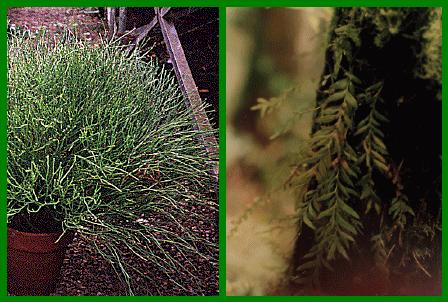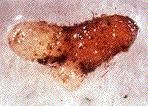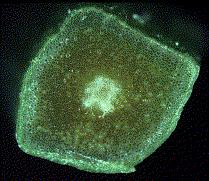Introduction to the Psilotales
the whisk ferns


The Psilotales are the least complex of all terrestrial vascular plants, and were once believed to be remnants of an otherwise extinct Devonian flora. This is primarily because psilophytes are the only living vascular plants to lack both roots and leaves. Though they have been considered “primitive,” recent developmental and molecular evidence suggests that the group may actually be reduced from fern-like ancestors. There is not universal agreement on this, but we here treat them with the ferns for that reason. Despite the uncertainty of their relationships, psilophytes do structurally resemble certain early vascular plants, and are used as a model for understanding the ecology of these plants.
This is a small group with only two genera, Psilotum, shown above left, and Tmesipteris, above right, neither with many species. Both genera grow in tropical or subtropical regions, where they occur on rich soil or as epiphytes. Psilotum occurs in North America in the Caribbean, and along the Gulf and Atlantic Coasts to as far north as North Carolina, and has been reported from one locality in Arizona. It may also be found in tropical Asia and on Pacific islands. Tmesipteris grows in New Caledonia and nearby areas of the South Pacific, including Australia and New Zealand.
In addition to its natural distribution, Psilotum is also found as a common weed in greenhouses, and sometimes escapes cultivation in regions with mild climate. It occasionally becomes a nuisance, but is still very popular for its unusual growth form. In Japan, more than 100 unusual breeds have been produced, some of them highly prized by cultivators.
The Psilotales have no fossil record at all.
The psilophyte stem lacks roots; it is anchored instead by a horizontally creeping stem called a rhizome. The erect portion of the stem bears paired enations, outgrowths which look like miniature leaves, but unlike true leaves, the enations have no vascular tissue. These paired outgrowths lie immediately below the spore-producing synangia, which produce the spores. The synangia appear to be the product of three sporangia which became fused over the course of evolution, and are borne on the tip of a short lateral branch. This is another feature in which the psilophytes differ from other living vascular plants; all other such plants produce their sporangia on their leaves. You can click on the picture of the synangia of Psilotum at right, for a better look at these structures.
 When the synangia mature, they open to release yellow to whitish spores,
from which the gametophyte plants will later emerge, like the one shown
at left. The gametophytes are very small, usually less than two millimeters long. They
are subterranean and saprophytic, getting their nutrition by
absorbing substances dissolved in the environment. This is often aided
by the presence of fungi which grow into the
tissues of the gametophyte and through the surrounding soil.
When the synangia mature, they open to release yellow to whitish spores,
from which the gametophyte plants will later emerge, like the one shown
at left. The gametophytes are very small, usually less than two millimeters long. They
are subterranean and saprophytic, getting their nutrition by
absorbing substances dissolved in the environment. This is often aided
by the presence of fungi which grow into the
tissues of the gametophyte and through the surrounding soil.
Eventually, the gametophyte reaches sexual maturity, producing both egg and sperm cells. The multiflagellate sperm swim to the egg cells, where they unite to begin the sporophyte generation. Psilophyte gametophytes may even self-fertilize to produce a sporophyte plant. The resulting sporophyte begins its life as a dependent on its parent gametophyte, as in other seedless plants. But unlike the “bryophytes,” the sporophyte eventually gains independence from its parent, and establishes itself in the environment.
 The mature sporophyte of Psilotum will often grow to 30 cm
tall, and may grow even taller. It has no true leaves, and instead the stem is
green and photosynthetic, being covered with stomates to allow gas
exchange. As the cross-section at right shows, the stem has a central
core of vascular tissue (protostele)
which is usually lobed. The thick-walled cells in the center of this core are
sometimes considered to be pith, in which case the vascular arrangement
would actually be a siphonostele. Surrounding the vascular tissue is a
layer called the endodermis, which has specially packed cells to
regulate flow of water and nutrients.
The mature sporophyte of Psilotum will often grow to 30 cm
tall, and may grow even taller. It has no true leaves, and instead the stem is
green and photosynthetic, being covered with stomates to allow gas
exchange. As the cross-section at right shows, the stem has a central
core of vascular tissue (protostele)
which is usually lobed. The thick-walled cells in the center of this core are
sometimes considered to be pith, in which case the vascular arrangement
would actually be a siphonostele. Surrounding the vascular tissue is a
layer called the endodermis, which has specially packed cells to
regulate flow of water and nutrients.
Tmesipteris has similar reproductive structures and life history to that of Psilotum, but by contrast it has broad leaf-like extensions of its stem, each with a single vascular bundle. These extensions may lie to either side of the stem, forming a flat growth, or they may be radially arranged. In any case, they are not considered leaves by most botanists, though this interpretation has been challenged by some workers.
There is a nice collection of Psilotum images at the University of Wisconsin; the image of the Psilotum gametophyte on this page was made available through them.


